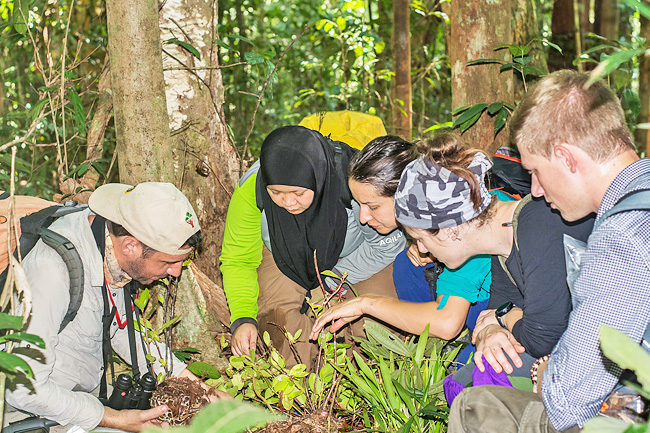Teams of citizen scientists on expeditions in the tropical rainforest of Ulu Temburong National Park, Brunei Darussalam have discovered a new species of ‘semislug’. Working with Taxon Expeditions, they managed to study the specimens, even analysed their DNA, in a field camp in the heart of the forest. The new species, published this week in the Biodiversity Data Journal, has been named microparmarion sallehi.
Semislugs, or ‘snugs’ as they are affectionately known among mollusc researchers, are like the squatters of the snail world: they do carry a home on their back but it is too small to live in. Still, it offers a sort of protection, while not getting in the way of the worm-like physique of the slug. For reasons unknown, on the island of Borneo, most slugs are of the semislug type. The genus microparmarion on the island consists of around 10 semislug species, most of which are found in the cooler forests of the mountains. Citizen scientists on an expedition were surprised to discover a microparmarion in the hot lowland forest of Ulu Temburong National Park.
For the past years, Taxon Expeditions, in collaboration with Universiti Brunei Darussalam (UBD), has been organising biodiversity discovery trips to the forest. On the first trip to Kuala Belalong Field Studies Centre (KBFSC), in 2018, during a night walk, participant Simon Berenyi reached up to a dead leaf suspended over the trail. Everybody had ducked and passed underneath this dead leaf without giving it a glance but something caught Berenyi’s eye.
“Oi, is that a slug?” he exclaimed, and picked a slimy, well-camouflaged mollusc off it.
At the time, the team’s zoologists already suspected it was a new species: nothing like it had ever been found in this corner of the island; but the single specimen was not enough to publish it as a new species.


Over the years, though, successive expeditions to the same area came up with several more specimens of the same species, which made it clear that it was really a species never seen before.
In the 2022 expedition, a team composed of UBD students Nurilya Ezzwan and Izzah Hamdani and citizen scientist from Virginia, the United States (US) Harrison Wu, finished the description.
Using the portable lab that Taxon Expeditions always carries with them, the team studied the animals’ shell, reproductive organs, and DNA, and prepared a paper for the open access Biodiversity Data Journal, where it was published this week.
KBFSC of the Institute for Biodiversity and Environmental Research (IBER) is UBD’s only field centre, located in the pristine forests of Brunei.
KBFSC serves as a key research, teaching and training site for local and international research community and universities.





